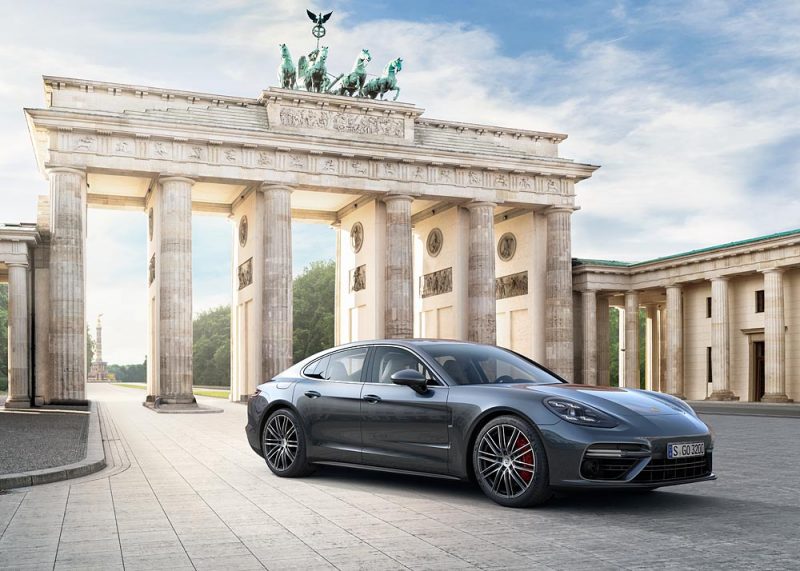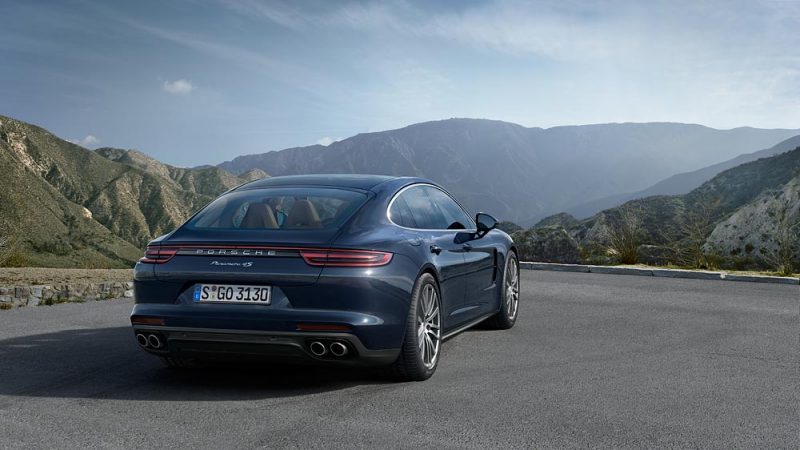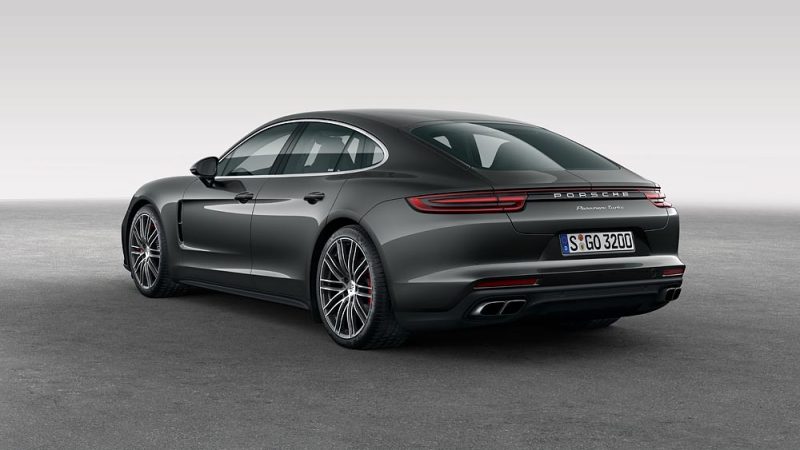Today, Porsche launched a long-awaited new version of the venerable Panamera sports sedan in Berlin. The launch featured loud music, a crazy light show, and a choreographed dance routine like something out of a drug-induced fever dream. Then, the new Panamera arrived on stage, and everything was okay again. The 2017 Porsche Panamera is a largely familiar face, and offers everything you liked about the existing Panamera in an edgier package.

Exterior Design
Porsche says the new car “offers both the performance of a sports car and the comfort of a luxury saloon“. They’ve been known to infuse sports car DNA into their non-sports car lineup, and the new Panamera certainly looks the part. From the outside you can see a lot of corporate design influence from the new 911 and the now-complete 918 Spyder. The four-LED headlamps are a blend of Panamera and 911. The front bumper certainly has a lot of 911 and 718 aggression in it. At the rear, the 991 lineage is clearly visible, as the rear bumper and tail lamps look like they were lifted straight from the 911.

Interior Design
Inside, the lineage is continued, with a 911 steering wheel and dash layout carried over. However, the new Panamera features a brand new screen in the center stack, much larger than before, a new-tech gauge cluster, and a redesigned center console “Waterfall”. The Panamera, when it first arrived, was the beginning of the current Porsche ‘waterfall’ design, so perhaps this is where we should look for future Porsche interiors across their lineup. In all, this interior looks quite nice. The new center stack features a number of touch-screen style light up buttons; I’m not sure how I feel about that. I tend to prefer the tactile feel of a click button, but then again, the new center console does look quite nice.
The rear seat infotainment system looks like it’s quite an improvement on the existing car as well. The screens all feature an interconnectivity that is “feature-oriented” with a ‘smartphone-like user interface and configurable LED screens’. It is a system that Porsche is calling “Porsche Advanced Cockpit”, and can even communicate with your phone to remotely control some vehicle functions.
Engines and Performance
The new Panamera launches initially with Turbo and 4S models, and both feature brand new engines (A Panamera 4S Diesel will be sold as well, though not in North American markets it would seem). The Panamera 4S turbocharged V6 engine has been downsized from 3 liters to 2.9 liters. Though no word has been officially given, the new engine is likely the same architecture as the engine it replaces. The twin-turbo V6 produces 440 horsepower and 405 lb-ft of torque, propelling the 4S to sixty miles per hour in just 4.2 seconds (when Sport Chrono equipped). The new Panamera Turbo features a brand new 4.0 liter twin-turbocharged V8 engine, which we believe comes to Porsche from the Audi brand (currently used in Audi’s S6/S7/S8 and RS6/RS7). The new engine produces 550 horsepower and 567 lb-ft of torque in Porsche trim, and will move a Panamera Turbo to 60 miles per hour in just 3.6 seconds (when Sport Chrono equipped). All engines are mated to a newly developed 8-Speed generation II Porsche DoppelKupplungsgetriebe transmission.

New Tech
To enhance both comfort and sportiness, the new Panamera features a three-chamber air ride suspension system, rear axle steering like that used on current 911s, and something called “electronic 4D Chassis Control”, which I’d love to hear more about in the future. The new systems are said to enhance sport driving, ride comfort, and even safety.
Porsche has also developed a night vision assistant, which uses thermal imaging to detect people and animals in the roadway. If you have the optional LED matrix headlamps, the computer will direct the lights to highlight these obstructions in the roadway beyond the normal field of vision to give you extra time to react. Porsche’s new InnoDrive system includes adaptive cruise control, which uses navigation data, radar signals, and video sensors to compute and activate the optimal speeds for given corners, inclines, and speed limits. The computer can automatically calculate the optimal gear selection, when to coast, and when to accelerate for the next three kilometers ahead of you.

Oliver Blume, Chairman of the Executive Board of Porsche AG:
“We have tapped into the segment of luxury sport saloons with the Panamera. Since it launched in 2009, more than 150,000 units of the Panamera have been sold. In the new model, you see here a completely redeveloped automobile – with new engines, a new design and new technologies. Also new is that we are now manufacturing the second generation vehicle entirely at our Leipzig production site. We have also invested a sum of 500 million euros – which includes a completely new body manufacturing facility.
The design language of the new Panamera creates a link to the Porsche 911 by its even more dynamic flyline and specific design elements of the sports car icon. “An observer will immediately recognise the coupé-like roof line, but now it is much ‘faster’, even more dynamic and now includes a new side window look that emphasises the coupé-like side view even more,” said Michael Mauer, Head of Style Porsche AG, who explained the design targets that were set for the new model: “The new Panamera can be made out at first glance as a Panamera, but also as the new Panamera. Its strengths have been reinforced, its weaknesses eradicated and above all its character preserved.”
2017 Porsche Panamera Pricing and Delivery
Your local Porsche dealer is already prepared to accept orders on the new cars, and US deliveries will likely begin in Q4 of this year. US prices start at $99,900 for the Panamera 4S, and $146,900 for the Panamera Turbo.
The first units will begin arriving in Canada in the first quarter of 2017 with pricing starting at $114,300 for the Panamera 4S and $167,700 for the Panamera Turbo.

Fuel Consumption and Emissions
Panamera 4S: Fuel consumption combined 8.2 – 8.11 l/100 km; CO2-emissions 186 – 1841 g/km
Panamera 4S Diesel: Fuel consumption combined 6.8 – 6.71 l/100 km; CO2-emissions 178 – 1761 g/km
Panamera Turbo: Fuel consumption combined 9.4 – 9.31 l/100 km; CO2-emissions 214 – 2121 g/km
These numbers are obviously based on the European cycle, and have not been corroborated by the EPA yet. However, as it stands, the ballpark figures would place the 4S around 29 MPG and the Turbo around 25 MPG combined.
